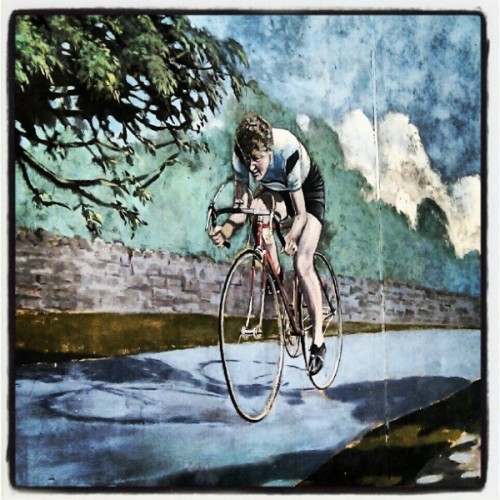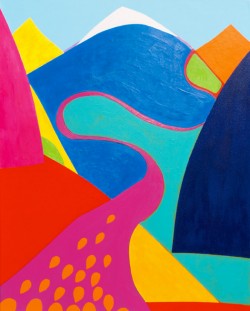
Guest blog by Ian Street
When I watch the pro bike racing on TV one of the things that has always struck me is the sheer visual nature of the spectacle and in particular the peloton sweeping down a mountain pass writhing their way through a series of S-bends. The fluidity of movement encapsulated in these moments has always reminded me of brushstrokes swept across a canvas with the sponsored team jerseys providing a vivid blur of primary colour often offset against stunning visual scenery.

It’s no surprise to me that artists have looked to capture this colour and motion in many guises, for example David Gerstein or a particular current favourite of mine in the recently commissioned Euskaltel by Chris Billington (right) depicting the orange kit of the Euskaltel Euskadi team snaking their way up into their Basque Pyrenean homeland.
Other artists such as Alexander Calder (Six Day Bike Race – 1924) or Leroy Neiman (Indoor Cycling – 1979) have sought to capture action similar to that we will see on the velodrome at the forthcoming Olympics when for a brief moment the population at large will become aware of the sport and Laura Trott will become a household name. In contrast to these paintings that seek to exploit the fluidity of movement inherent in cycling I particular like Edward Hopper’s 1937 painting French Six Day Bicycle Rider which shows the rider (in my view anticipating the motion to come through the stillness) before he competes. Six day racing was very popular at the time (hence the similarity with Calder’s title) and Hopper regularly went to watch the racing at Madison Square Gardens and although Hopper did not say who the rider was in picture the likelihood is that it was Alfred Letourner a regular winner at the Gardens in the period and nicknamed ‘Le Diable Rouge’
The feeling of flow is something of a holy grail among those of us who ride, that moment when all your feelings, emotions and senses coalesce with your physical movements and you slip into a bubble where there are no thoughts just oneness of movement. I don’t find it that often but when I ride the Yorkshire Dales single track treading in Turner’s footsteps I sometimes stumble across it and I wonder whether this heightening of the senses, being totally aware of your surroundings and colours is what artists feel when they find their muse? As a cyclist you will invariably find yourself riding past the same landmarks time after time and in doing so you will notice the subtle changes of immediate surrounds as you pass through the seasons in a way that has been perfectly encapsulated by Hockney in his most recent exhibition with paintings of the same lane or same tree over a period of time. I could immediately identify with this and now keep seeing “Hockney’s” whenever I ride. I guess however that this feeling can be better summed up by someone who can actually write so here’s Hemmingway:
“It is by riding a bicycle that you learn the contours of a country best, since you have to sweat up the hills and coast down them. Thus you remember them as they actually are, while in a motor car only a high hill impresses you, and you have no such accurate remembrance of country you have driven through as you gain by riding a bicycle.”
I sometimes wonder how bikes have affected art in ways that we cannot measure, how did some of the landscape artists of the early 20th century get to their destination? In my mind they cycled there and this ability of the bike to take us further afield must have had an effect on the art being produced at the time? In a way this process is still happening today as land artist Richard Long is known to cycle down to his favourite muddy bank before collecting mud to put in his saddlebag before riding back to the studio to get to work.
Art and bikes move much further though than simply the depiction of racing or bikes in the form to which most people imagine when they think of a bike. Take the fantastically titled 1920 painting by Max Ernst – The Gramineous Bicyle Garnished with Bells the Dappled Fire Damps and the Echinoderms Bending the Spine to Look for Caresses !
I think that this picture was one of the first pieces of bike art that began to disassemble the bike and was the forerunner, alongside Marcel Duchamp’s Bicycle Wheel (1913), to those who realised that the bike’s genius simplicity and component parts make the perfect materials to produce some of the most eye catching and memorable work of the 20th Century, most notably with the Head of a Bull (1942) by Pablo Picasso at the top of the piece that uses the saddle and handlebars and is probably instantly recognisable for many people. This tradition of using the bike itself as the art rather than depicted bikes in art has continued through to the modern day with Ai Weiwei Bicycles – 1200 bikes formed together into this remarkable structure:
I love the way that all of the artists who work in this way from Duchamp through to Weiwei are taking a brilliantly designed but essentially humble everyday item and seeking to expand our horizons to what is possible and surely all those who saddle up seek to explore expanded horizons?
The bikes of Duchamp, Picasso and Weiwei could not of course be ridden but many many cyclists enjoy the concept of creating or modifying their own bike and applying colour schemes, designs, details and frame decals and the controversial Lance Armstrong got in on the idea when he rode a series of customised art bikes in the Tour de France that were then auctioned off for his Livestrong charity. The artists KAWS, Kenny Scharf, Shepard Fairey, Marc Newson, Yoshitomo Nara and Damien Hirst produced a serious of one offs with my fav being that by Yoshitomo Nara.
Once you start customising bikes people can tend to get very obsessive, a trait I suspect that might exist in the art world, that can be perhaps be best illustrated by the people who actually tattoo the brand logo of bike part manufacturer Campagnolo onto themselves, which might be the perfect manifestation of bike art?
The most recent trend in using bikes as art would, I suspect, never be considered art by those who do it and that’s the Ghost Bike movement whereby bikes are sprayed white and tied up at the site where a cyclist has been killed. I’m not sure where I stand on Ghost Bikes but they remind me very much of the Situationist Art movement where all art was done for a political reason and when you first come across a Ghost Bike it very much makes you think about your own mortality, what happened at that site and why? what changes need to happen to prevent further Ghost Bikes appearing? If Guernica can bring to our attention what is happening in the world around us and can challenge us with profound questions then I think Ghost Bikes do the same thing and are very much in the best tradition of art with a purpose.
Bike art has continued to develop as different mediums for expression have developed and photography and film have perhaps proved the perfect medium. Graham Watson has been photographing cycling for 30 years producing any number of breathtaking images and new kid on the block Jered Gruber I particularly like for his ability to really capture the soul and culture of cycling and bike racing. Film makers in this area are mushrooming and there are now film festivals dedicated to all things bike. Channel 4 got in on the act last year through their Concrete Circus series of films and the 2 bike films in particular reminded me of the grace, control, balance and rhythm that any dancer would be proud of, especially when you watch Flatland BMX specialist Keelan Phillips get to work. If you have not seen Danny or Keelan ride before the prepare to be amazed.
For many of us however the bike does not need to be depicted as art the bike itself is art and none more so than currently being demonstrated by the growing artisan bespoke movement in this country producing some of the most beautiful creations imaginable that achieve the difficult marriage of form and function to perfection. There are none better than Yorkshire’s own Ricky Feather (who I’m hoping will be building my next bike in the future) and we should celebrate these craftspeople and their skill and creativity.
So since the first bike pedal was turned they have influenced countless artists and continued to do so through developing mediums. A question often asked is what is art ? and for me the answer is freedom, whether that be creative freedom or freedom of expression. Art is what people do and have always done there is a primal urge within all of us to create (admittedly well hidden in some of us) and that is it’s essential link to bikes as if you ask people what riding gives them from the very youngest upwards the word freedom will consistently appear, perfectly summed up in 1896 by Susan Brownwell Anthony:
“Let me tell you what I think of bicycling. I think it has done more to emancipate women than anything else in the world. It gives women a feeling of freedom and self-reliance. I stand and rejoice every time I see a woman ride by on a wheel…the picture of free, untrammelled womanhood.”
For me though perhaps the piece of cycling art that means most to me is the one that I cycle past regularly a few minutes from my house. A wall at the back of a row of shops that has been painted to commemorate Beryl Burton, Britain’s greatest ever cyclist (and in my view greatest sportsperson). Fine though it is I feel it is time for a new piece of bike art and that is a sculpture of Beryl for the centre of Leeds.
Ian Street regularly blogs over at Into The Orchard. And not just about bikes.